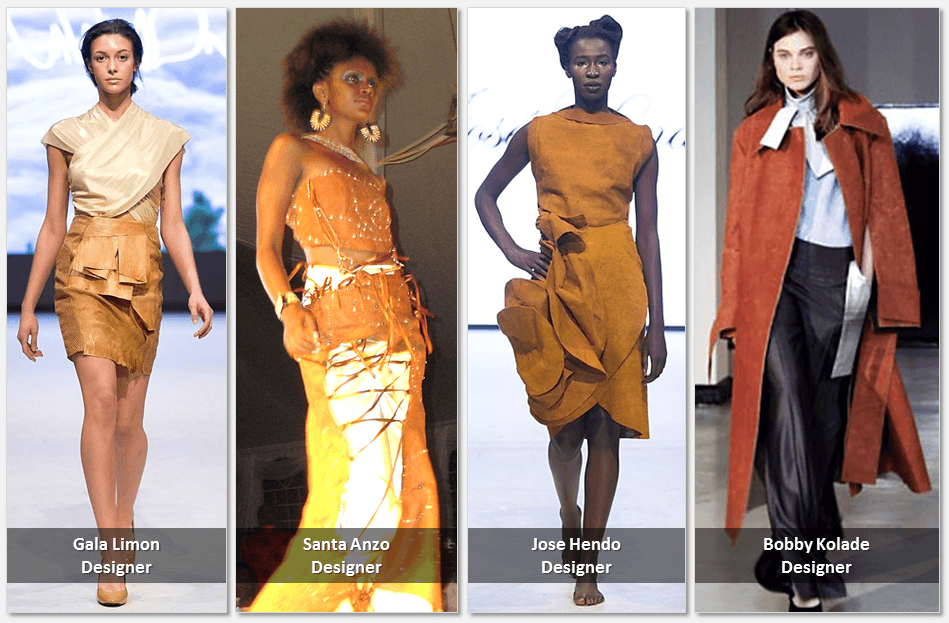African Fashion History
3 mins read
Could Barkcloth from the Mutuba Tree Be Africa’s Best Shot at Sustainable Fashion? Here’s How.
By Joy Oshiokenoya
June 3, 2025
Barkcloth from Africa’s Mutuba tree offers a unique and ancient solution to sustainable fashion. Harvested without harming the tree, this biodegradable, chemical-free fabric embodies centuries-old traditions of eco-conscious craftsmanship. This article explores how barkcloth not only preserves cultural heritage but also inspires modern designers, proving that sustainable innovation can come from honoring the past as much as looking to the future.

Runway models wearing contemporary outfits made from Ugandan barkcloth by various designers, showcasing the fabric's use in modern sustainable fashion. Image source: Pinterest
I was recently at a virtual event on sustainable fashion hosted by eco-sustainable designer, José Hendo when I heard something that instantly caught my attention. The Mutuba tree is native to Africa, and Hendo talked about the cultural relevance of the barkcloth made from this tree, and how it is the perfect representation for sustainability.
This was my first time hearing about the Mutuba tree, and the more I listened, its significance became clearer. And its larger role in Africa's sustainable fashion was ever more obvious.
Watch José Hendo’s video on TikTok
African fashion has a long history rooted in sustainability. From our dyeing techniques to the way we source fabric and our tradition of bespoke tailoring, we’ve always embraced a conscious approach to fashion. Learning about the Mutuba tree and the barkcloth made from it only reinforces that truth.
The Mutuba Tree

Aerial roots of the Mutuba tree. Image source: Wikizer
The Mutuba tree (Ficus natalensis) is native to East Africa, including Uganda and other parts of Kenya as well as north-eastern South Africa. It produces a fabric called barkcloth, and it is central to one of the oldest known textile-making traditions in the world.
Here's the part that truly amazed me: you don’t need to cut the tree down to get the fabric. Unlike most tree-based textiles like viscose and rayons, barkcloth is made by gently removing the bark without harming the tree.
Skilled artisans handle the process in a way that lets the tree regenerate naturally.
A single tree can live for decades and produce barkcloth over and over again. It feels like the kind of sustainable innovation the fashion industry has been searching for, even though it’s been practised in Africa for centuries.
Traditionally, barkcloth hold spiritual and ceremonial value in Ugandan culture. It was worn by royalty and used in important rituals. It is a symbol of identity, continuity, and respect for nature.
In this short video, TikToker The Rainforester, explains how barkcloth is obtained from the Mutuba tree without cutting it down.
Watch The Rainforester’s video on TikTok
Why Barkcloth Matters
Barkcloth stands out as a one-of-a-kind sustainable fabric because it is biodegradable, chemical-free, locally sourced, and made entirely without industrial machines or waste. Its production process is rooted in tradition, making it both environmentally friendly and culturally significant.
Infact, UNESCO recognises barkcloth as a Masterpiece of the Intangible Cultural Heritage of Humanity, highlighting its cultural and sustainable value.
Today, designers continue to honour and elevate barkcloth on global stages. In February 2025, Ugandan textile experts Josephine Mukasa and Pamela Kyagera showcased the barkcloth as part of their AW25 Sprouts Collection at Paris fashion week. Other designers like José Hendo and Ugandan street wear brand ORM, continue to exemplify the innovative use of barkcloth, merging sustainability with cultural narratives.
Oftentimes, when we think about innovation in the sustainable fashion space, we tend to focus on the future. Meanwhile, a look at our past reveals innovative examples – such as the barkcloth from the Mutuba tree — that have existed for centuries. This offers a slow, thoughtful alternative to fast fashion and reminds us that sustainable innovation isn’t always about what’s new.
Like Post
Comments
Favour
6/5/2025Insightful
Related Posts
MoreRita Idehai, on Waste, Work, and Driving Social Impact in Nigeria
Through Ecobarter and its fashion arm, Wrep, Rita Idehai is transforming plastic waste into fabric, and creating new pathways for women and communities to thrive.
Miss Green Fashion ‘25: Celebrating Beauty, Sustainability, and Impact
Miss Green Fashion is redefining beauty with purpose, promoting sustainability, creativity, and women’s empowerment.
10 Sustainable Fashion Habits You Can Start Today
We highlight 10 simple everyday habits to make your fashion choices more sustainable, from rewearing and repairing to thrifting and supporting local artisans.
The Hidden Plastics in Our Clothes
Much of our clothing is made from plastic-based fabrics like polyester and nylon. Learn their impact and how to choose more sustainable options.